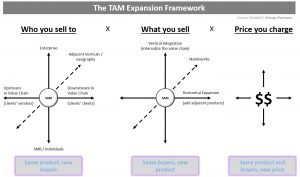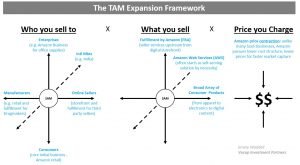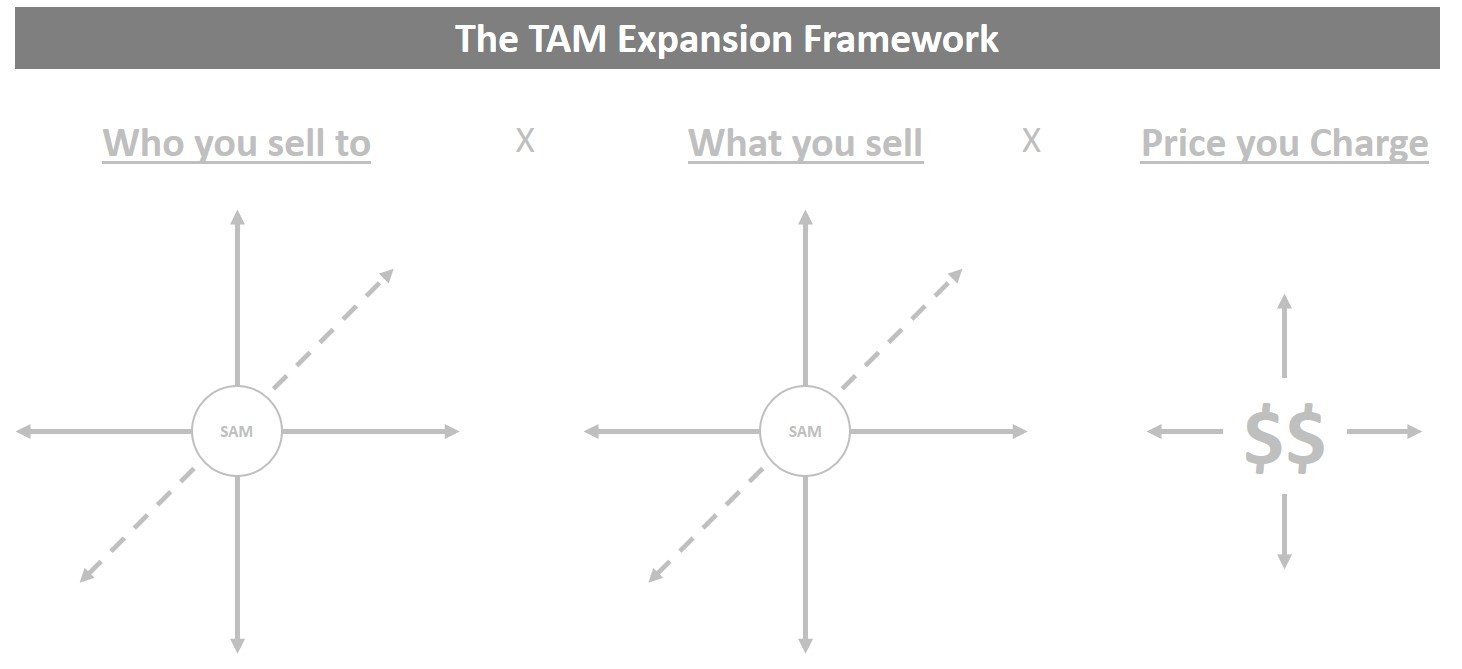Introducing the TAM Expansion Framework
Key takeaways upfront:
- Total addressable market (TAM) can expand over time. ‘Small market bias’ can lead to big missed opportunities for both investors and business managers.
- Many businesses don’t effectively evaluate and prioritize market expanding opportunities (enter the TAM expansion framework below)
- TAM growth is a function of three components: who you sell to, what you sell and the price you charge
- Key rules of thumb for using the framework to expand your opportunity: (i) prioritize rigorously (notes on how to do this below), (ii) look ahead, (iii) don’t harm the core, (iv) determine if the new part needs a different machine
Few things are as important as picking your market(s). In my first post on total addressable market (TAM), I argued we should guard against being too myopic on TAM because it can change and expand over time. Since publishing part 1, we’ve had a lot of lively discussion both internally and externally. Clearly it struck a chord with a broad audience.
So how exactly does a company go about expanding its opportunity over time? To help navigate this important and natural next question, I’ve been developing a new framework shown below.
At its core, TAM growth is a function of expanding at least one of three components: who you sell to, what you sell and the price you charge. Sounds obvious enough, but as you’ll see, applying this model correctly can provide much needed clarity and creativity at critical junctures in a company’s journey to scale.

Dotted axes indicate a 3rd dimension.
SAM = Serviceable Addressable Market
Key Considerations When Using the Framework
Granted, some businesses face a deeper chasm between these vectors and I’m not suggesting any business can become Amazon given great execution (see case study below). But the point remains: it’s the rare exception in which a business simply has nowhere to go. When evaluating how to expand your opportunity, keep in mind the following.
Prioritize rigorously:
The next logical question is how to evaluate and prioritize these expansion opportunities. This part is absolutely critical and often separates the breakout winners from those that plateau: the paths are likely there, but effective navigation is key. Here are some key considerations:
- Size of incremental opportunity (juice worth the squeeze?)
- Resource requirements
- Degree to which it leverages current comparative advantages
- Knowhow required (is it already ‘in the building’ or will you need to go find it?)
- Level of competition (white space or overcrowded?)
- Time to execute
- Does it align with company mission (the north star)
- I’m sure I’m missing things – what else?
Look ahead:
I think a good rule of thumb for scaling companies is to always have the next one or two TAM expansion opportunities in the works, even if the remaining runway with the current product and target market seems long. These vectors often take a while to spin up and the next investor / acquirer will need to see upside – the ‘meat left on the bone’ – to justify a high valuation. The sooner you start collecting data points to validate those incremental opportunities the more credit you’ll get.
Don’t harm the core:
The best strategists I’ve seen also recognize that none of this should be done at the cost of the company’s core competency or what makes the product compelling to the core market. Assuming the core business isn’t completely broken or facing total obsolescence, TAM expansion efforts should both reinforce and leverage the core strengths.
Determine if the new part goes to a different machine:
When you change either market or product, consider whether you need to also change your channel or model. One of the biggest mistakes is thinking you can just change one of those four elements and then sales will hockey stick. Brian Balfour who helped Hupspot build its self-service product for individual sales reps (an unusual example of a saas company going down market with a new product) has a great series on this.
A note on organic vs. M&A:
Growth along any of these vectors can happen either organically or inorganically (via acquisitions). For the purpose of this piece I’ve focused on the organic path which is much more common in the early/mid stage of a company’s maturation.
Applying the Framework – Amazon Case Study:
Amazon is perhaps the most famous case study on expanding from an initial addressable market. There’s a frequently quoted criticism from naysayers in the early days of the business: “Amazon sells books”. Yes, that’s where they started, but obviously they do a little more than that now. Let’s look at the TAM expansion framework to see some ways the company went from an “online bookseller” to the global behemoth it now is. Note: this case study is decidedly incomplete as Amazon’s customer base and product offering is extraordinarily diverse. It’s also difficult in many cases to distinguish between customer, supplier and partner in the Amazon ecosystem. The point is to provide examples of Amazon’s TAM expansion maneuvers over the years by using the framework in action.

Some commentary on the vectors in this example:
- Who you sell to:
- Consumers: this is where Amazon started and continues to focus – online shoppers
- Online Retailers: Amazon opened its marketplace to third party sellers in 2000; these sellers gained access to a highly effective sales channel in exchange for a small flat fee plus a percentage of sales.
- Manufacturers: similar to the value proposition to online retailers, Amazon provides a sales channel and fulfillment services to manufacturers, bypassing supply chain intermediaries. Amazon’s heavy push into pharma – accelerated by the PillPack acquisition – is a good example of the company targeting manufacturers (i.e. drugmakers) as customers. Per my note above, the line between supplier and customer can get muddy. For the purpose of this, just think about Amazon selling its product (online storefront and fulfillment) to this group of customers (manufacturers).
- Enterprises: Amazon Business represents the company’s expansion into business-to-business (B2B) e-commerce, a total addressable market of $1.4 trillion by 2021 according to BofA, which is nearly double the firm’s estimated $761 billion market for consumer e-commerce (albeit a moving target). In business supplies, for example, Amazon is applying its existing product strengths (price, speed, convenience) with a new B2B wrapper, which includes features like spend analytics and integrations with procurement apps.
- International: this is perhaps the most straightforward; Amazon is currently the fastest growing marketplace in India, for example, and continues to push aggressively into many countries around the world
- What you sell:
- Fulfillment by Amazon (FBA): after establishing its supply chain as a clear strategic advantage (aka vertical integration), Amazon launched its Fulfillment By Amazon service in 2006. As Kiri Masters put it in a Forbes article, this groundbreaking program offered sellers access to Amazon’s vast network of fulfillment centers to store, pick, pack and ship their customer’s orders, all for a predictable fee—no matter where the item was shipped to.
- Amazon Web Services (AWS): in the early 2000s, Amazon’s growth and several large new partnerships precipitated the need to improve its internal infrastructure service. The company needed to accelerate the speed of development and avoid availability bottlenecks. A few experimental years later, AWS was born and later offered as a public service. Great products can begin as a self-serving solution by necessity. If others have that same problem, maybe you have a new product to sell.
- Broad Array of Consumer Products: In 1998 after extending beyond books to CDs and DVDs, Jeff Bezos asserted: ”we’re at an inflection point where we are now looking at a broader range of products” (a hilarious understatement to look back on now). Then they started selling toys, then games, then beauty products. These hardgoods had important similarities to books which made them natural inventory extensions at that time. Since then, Amazon has methodically added just about every consumer product under the sun.
______
This is a great topic and one that doesn’t get enough attention. Few things are as important as picking your market(s). I’m sure I’ll continue to learn and refine this framework as I apply it to the businesses we work with (I already have).

